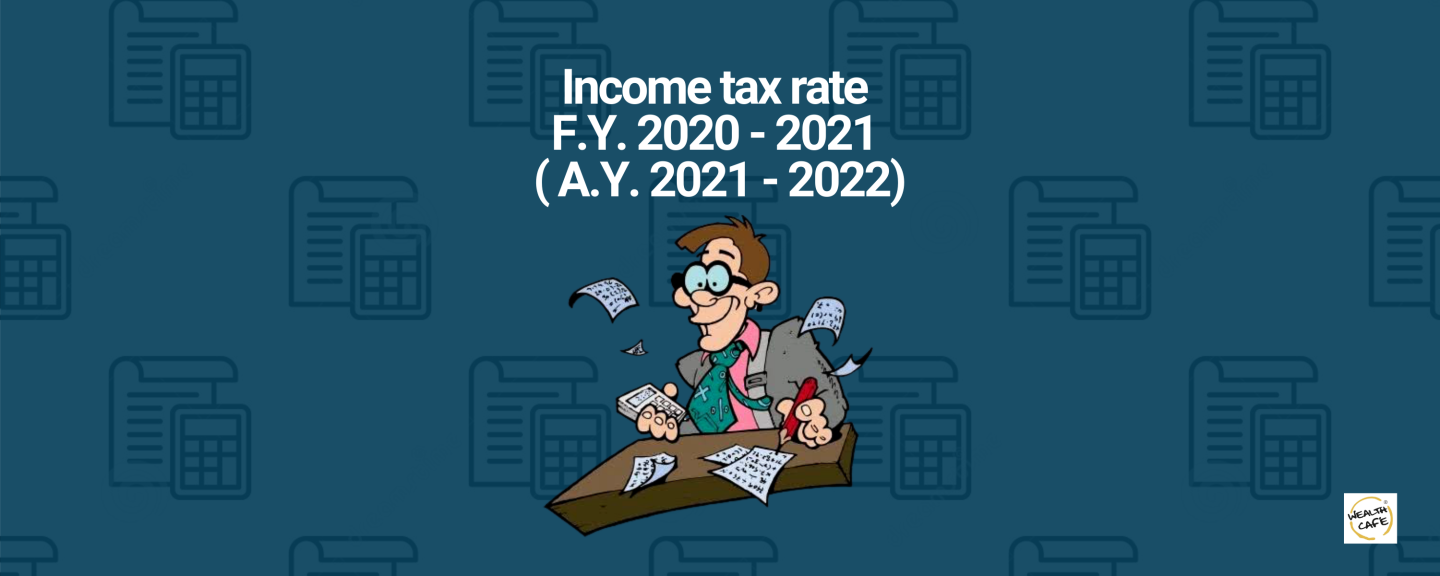Before knowing the tax rates, it is very important to understand the terms Financial year (FY) and Assessment Year (AY).
The below-mentioned tax rates/ slab is on the income earned for the period 1 April 2020 to 31 March 2021. FY stands for the ‘financial year’ which is from 1 April 2020 to 31 March 2021. AY stands for Assessment year which 2021-22.
For individuals, the due date to file the income tax return for the income earned from 1 April 2020 to 31 March 2021 is 31 July 2021. However, this year due to COVID 19 economic relaxations, the due date is pushed to 30 November 2021
Income tax Rates
- Income Tax Rate & Slab for Individuals & HUF:
- Individual (Resident or Resident but not Ordinarily Resident or non-resident), who is of the age of less than 60 years on the last day of the relevant previous year & for HUF:
| Taxable income | Tax Rate (Existing Scheme) |
Tax Rate (New Scheme) |
| Up to Rs. 2,50,000 | Nil | Nil |
| Rs. 2,50,001 to Rs. 5,00,000 | 5% | 5% |
| Rs. 5,00,001 to Rs. 7,50,000 | 20% | 10% |
| Rs. 7,50,001 to Rs. 10,00,000 | 20% | 15% |
| Rs. 10,00,001 to Rs. 12,50,000 | 30% | 20% |
| Rs. 12,50,001 to Rs. 15,00,000 | 30% | 25% |
| Above Rs. 15,00,000 | 30% | 30% |
- Resident or Resident but not Ordinarily Resident senior citizen, i.e., every individual, being a resident or Resident but not Ordinarily Resident in India, who is of the age of 60 years or more but less than 80 years at any time during the previous year:
| Taxable income | Tax Rate (Existing Scheme) |
Tax Rate (New Scheme) |
| Up to Rs. 2,50,000 | Nil | Nil |
| Rs. 2,50,001 to Rs. 3,00,000 | Nil | 5% |
| Rs. 3,00,001 to Rs. 5,00,000 | 5% | 5% |
| Rs. 5,00,001 to Rs. 7,50,000 | 20% | 10% |
| Rs. 7,50,001 to Rs. 10,00,000 | 20% | 15% |
| Rs. 10,00,001 to Rs. 12,50,000 | 30% | 20% |
| Rs. 12,50,001 to Rs. 15,00,000 | 30% | 25% |
| Above Rs. 15,00,000 | 30% | 30% |
- Resident or Resident but not Ordinarily Resident super senior citizen, i.e., every individual, being a resident or Resident but not Ordinarily Resident in India, who is of the age of 80 years or more at any time during the previous year:
| Taxable income | Tax Rate (Existing Scheme) |
Tax Rate (New Scheme) |
| Up to Rs. 2,50,000 | Nil | Nil |
| Rs. 2,50,001 to Rs. 5,00,000 | Nil | 5% |
| Rs. 5,00,001 to Rs. 7,50,000 | 20% | 10% |
| Rs. 7,50,001 to Rs. 10,00,000 | 20% | 15% |
| Rs. 10,00,001 to Rs. 12,50,000 | 30% | 20% |
| Rs. 12,50,001 to Rs. 15,00,000 | 30% | 25% |
| Above Rs. 15,00,000 | 30% | 30% |
- Surcharge:
a) 10% of Income tax where total income exceeds Rs.50 lakh
b) 15% of Income tax where total income exceeds Rs.1 crore
c) 25% of Income tax where total income exceeds Rs.2 crore
d) 37% of Income tax where total income exceeds Rs.5 crore - Note:Enhanced Surcharge rate (25% or 37%) is not applicable in case of specified incomes I.e. short-term capital gain u/s 111A, long-term capital gain u/s 112A & short-term or long-term capital gain u/s 115AD(1)(b).
- Education cess:4% of income tax plus surcharge
- Note: A resident or Resident but not Ordinarily Resident individual is entitled to rebate under section 87A if his total income does not exceed Rs. 5, 00,000. The amount of rebate shall be 100% of income-tax or Rs. 12,500, whichever is less. rebate under section 87A is available in both schemes I.e. existing scheme as well as new scheme.
- Income Tax Rates for AOP/BOI/Any other Artificial Juridical Person:
| Taxable income | Tax Rate |
| Up to Rs. 2,50,000 | Nil |
| Rs. 2,50,001 to Rs. 5,00,000 | 5% |
| Rs. 5,00,001 to Rs. 10,00,000 | 20% |
| Above Rs. 10,00,000 | 30% |
Surcharge:
a) 10% of Income tax where total income exceeds Rs.50 lakh
b) 15% of Income tax where total income exceeds Rs.1 crore
c) 25% of Income tax where total income exceeds Rs.2 crore
d) 37% of Income tax where total income exceeds Rs.5 crore
Note: Enhanced Surcharge rate (25% or 37%) is not applicable in case of specified incomes I.e. short-term capital gain u/s 111A, long-term capital gain u/s 112A & short-term or long-term capital gain u/s 115AD(1)(b).
Education cess: 4% of tax plus surcharge
- Tax Rate for Partnership Firm:
A partnership firm (including LLP) is taxable at 30%.
Surcharge: 12% of Income tax where total income exceeds Rs. 1 crore
Education cess: 4% of Income tax plus surcharge
- Income Tax Slab Rate for Local Authority:
A local authority is Income taxable at 30%.
Surcharge: 12% of Income tax where total income exceeds Rs. 1 crore
Education cess: 4% of tax plus surcharge
- Tax Slab Rate for Domestic Company:
A domestic company is taxable at 30%. However, the tax rate is 25% if turnover or gross receipt of the company does not exceed Rs. 400 crore in the previous year.
| Particulars | Tax Rate(%) |
| If turnover or gross receipt of the company does not exceed Rs. 400 crore in the previous year 2018-19 | 25% |
| If the company opted section 115BA (Note 1) | 25% |
| If the company opted for section 115BAA (Note 2) | 22% |
| If the company opted for section 115BAB (Note 3) | 15% |
| Any other domestic company | 30% |
Note 1: Section 115BA - A domestic company which is registered on or after March 1, 2016 and engaged in the business of manufacture or production of any article or thing and research in relation to (or distribution of) such article or thing manufactured or produced by it and also It is not claiming any deduction u/s 10AA, 32AC, 32AD, 33AB, 33ABA, 35(1)(ii)/(iia)/(iii)/35(2AA)/(2AB), 35AC, 35AD, 35CCC, 35CCD, section 80H to 80TT (Other than 80JJAA) or additional depreciation, can opt section 115BA on or before the due date of return by filing Form 10-IB online. Company cannot claim any brought forwarded losses (if such loss is related to the deductions specified in above point).
Note 2: Section 115BAA - Total income of a company is taxable at the rate of 22% (from A.Y 2020-21), if the following conditions are satisfied:
- Company is not claiming any deduction u/s 10AA or 32(1)(iia) or 32AD or 33AB or 33ABA or 35(1)(ii)/(iia)/(iii)/35(2AA)/(2AB) or 35AD or 35CCC or 35CCD or section 80H to 80TT (Other than 80JJAA).
- Company is not claiming any brought forwarded losses (if such loss is related to the deductions specified in above point).
- Provisions of MAT is not applicable on such company after exercising of option. company cannot claim the MAT credit (if any available at the time of exercising of section 115BAA).
Note 3: Section 115BAB - Total income of a company is taxable at the rate of 15% (from A.Y 2020-21), if the following conditions are satisfied:
- Company (not covered in section 115BA and 115BAA) is registered on or after October 1, 2019 and commenced manufacturing on or before 31st March, 2023.
- Company is not formed by splitting up or reconstruction of a business already in existence.
- Company does not use any machinery or plant previously used for any purpose.
- Company does not use any building previously used as a hotel or a convention center, as the case may be.
- Company is not engaged in any business other than the business of manufacture or production of any article or thing and research in relation to (or distribution of) such article or thing manufactured or produced by it. Business of manufacture or production shall not includes business of -
- Development of computer software;
- Mining ;
- Conversion of marble blocks or similar items into slabs;
- Bottling of gas into cylinder;
- Printing of books or production of cinematographic film; or
- Any other notified by Central Govt.
- Company is not claiming any deduction u/s 10AA or 32(1)(iia) or 32AD or 33AB or 33ABA or 35(1)(ii)/(iia)/(iii)/35(2AA)/(2AB) or 35AD or 35CCC or 35CCD or section 80H to 80TT (Other than 80JJAA and 80M).
- Company is not claiming any brought forwarded losses (if such loss is related to the deductions specified in above point).
- Provisions of MAT is not applicable on such company after exercising of option. company cannot claim the MAT credit (if any available at the time of exercising of section 115BAA).
Surcharge:
a) 7% of Income tax where total income exceeds Rs.1 crore
b) 12% of Income tax where total income exceeds Rs.10 crore
c) 10% of income tax where domestic company opted for section 115BAA and 115BAB
Education cess: 4% of Income tax plus surcharge.
- Tax Rates for Foreign Company:
A foreign company is taxable at 40%
Surcharge:
a) 2% of Income tax where total income exceeds Rs. 1 crore
b) 5% of Income tax where total income exceeds Rs. 10 crore
Education cess: 4% of Income tax plus surcharge.
| Taxable income | Tax Rate (Existing Scheme) |
Tax Rate (New Scheme) |
| Up to Rs. 10,000 | 10% | - |
| Rs. 10,001 to Rs. 20,000 | 20% | 22% |
| Above Rs. 20,000 | 30% | - |
- Income Tax Slab for Co-operative Society:
Surcharge:
- a) 12% of Income tax where total income exceeds Rs. 1 crore
- b) In case of Concessional scheme, surcharge rate is 10%
Education cess: 4% of Income tax plus surcharge.
Disclaimer: - The articles are for information purposes only. Information presented is general information that does not take into account your individual circumstances, financial situation, or needs, nor does it present a personalized recommendation to you. You must consult a financial advisor who understands your specific circumstances and situation before taking an investment decision.



